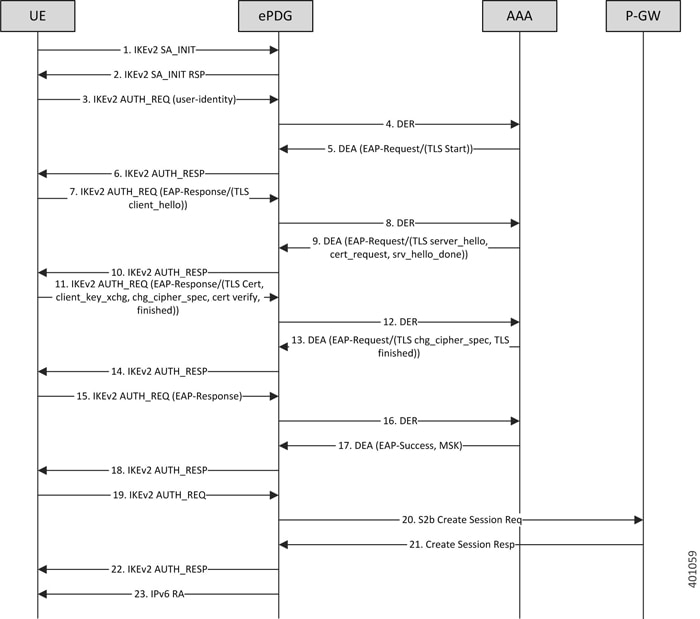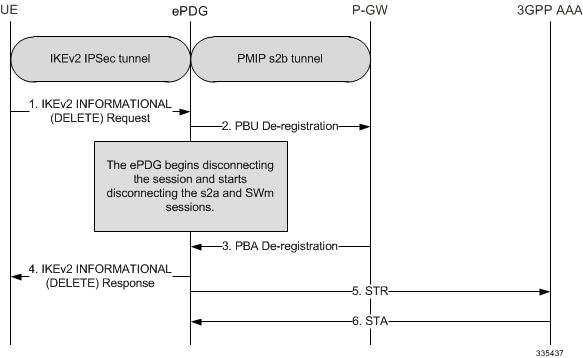Product Description
The Cisco® ePDG (evolved Packet Data Gateway) enables mobile operators to provide secure access to the 3GPP E-UTRAN/EPC (Evolved UTRAN/Evolved Packet Core) network from untrusted non-3GPP IP access networks. The ePDG functions as a security gateway to provide network security and internet working control via IPSec tunnel establishment based on information obtained during 3GPP AAA (Authentication, Authorization, and Accounting). The ePDG enables mobile operators to extend wireless service coverage, reduce the load on the macro wireless network, and make use of existing backhaul infrastructure to reduce the cost of carrying wireless calls.
The ePDG has the following key features:
- Support for the IPSec/IKEv2-based SWu interface between the ePDG and the WLAN (Wireless LAN) UEs.
- Routing of packets between the WLAN UEs and the Cisco P-GW (Packet Data Network Gateway) over the S2b interface via GTPv2 or PMIPv6 (Proxy Mobile IP version 6) protocol.
- P-GW selection via DNS client functionality to provide PDN (Packet Data Network) connectivity to the WLAN UEs.
- Support for passing assigned IPv4/IPv6 address configurations from the P-GW to the WLAN UEs.
- Support for the Diameter-based SWm interface between the ePDG and the external 3GPP AAA server.
- Tunnel authentication and authorization for IPSec/PMIPv6/GTPv2 tunnels using the EAP-AKA (Extensible Authentication Protocol - Authentication and Key Agreement) authentication method between the 3GPP AAA server and the WLAN UEs.
- Encapsulation and decapsulation of packets sent over the IPSec/PMIPv6/GTPv2 tunnels.
- Hosts a MAG (Mobile Access Gateway) function, which acts as a proxy mobility agent in the E-UTRAN/EPC network and uses PMIPv6 signaling to provide network-based mobility management on behalf of the WLAN UEs attached to the network.
Platform Requirements
The ePDG service runs on a Cisco ASR 5500 (DPC1/DPC2) chassis running the StarOS operating system and Virtualized Packet Core (VPC) platforms with optional crypto accelerator card (coleto creek). The chassis can be configured with a variety of components to meet specific network deployment requirements. For additional information, see the installation guide for the chassis and/or contact your Cisco account representative.
 Important |
The ePDG Hardware Crypto Assist (Coleto Creek) feature on VPC-DI is not fully qualified in this release. It is available only for testing purposes. For more information, contact your Cisco Accounts representative. |
 Important |
The ePDG Hardware Crypto Assist (Coleto Creek) feature on VPC-DI is fully qualified in release 21.6 and later releases. |
MIO Demux Card on ASR 5500
The ePDG service is fully qualified to run on the Management Input/Output (MIO) card for demux functions. ePDG can leverage on the additional card for user plane processing to increase the capacity of the chassis.
 Important |
When IPSec large and demux on MIO are configured together, enable the IPSec large feature (using the require ipsec-large command) before enabling the demux on MIO (using the require demux management-card command). |
For more information on the Demux card, refer the System Administration Guide.
 Important |
After you configure this command, you must save the configuration and then reload the chassis for the command to take effect. For information on saving the configuration file and reloading the chassis, refer to the System Administration Guide for your deployment. |
Licenses
The ePDG is a licensed Cisco product. Separate session and feature licenses may be required. Contact your Cisco account representative for detailed information on specific licensing requirements. For information on installing and verifying licenses, see "Managing License Keys" in the System Administration Guide.
























 Feedback
Feedback